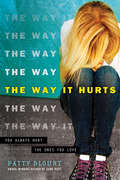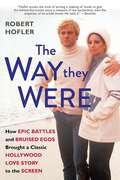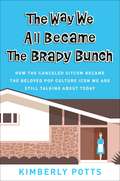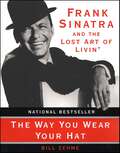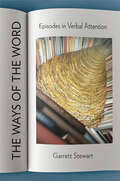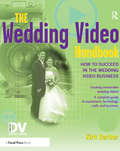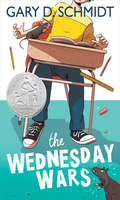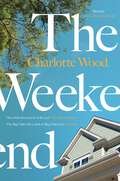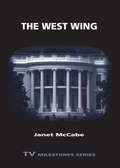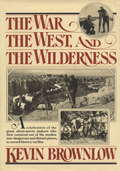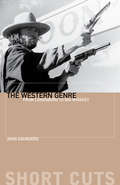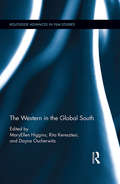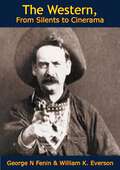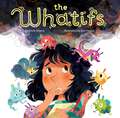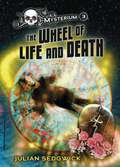- Table View
- List View
The Way I Was
by Marvin Hamlisch Gerald GardnerMarvin Hamlisch got his start as a rehearsal pianist for Funny Girl with Barbra Streisand, and went on to co-create A Chorus Line, write the Oscar-winning musical score for The Way We Were, and win many other awards for the music he wrote for the stage and screen. Hamlisch is one of only a handful of people to win a Grammy, a Tony, an Oscar, and an Emmy. In this revealing autobiography, written in partnership with noted freelance writer Gerald C. Gardner, Hamlisch tells the story of his childhood, his marriage, and his friendships with stars including Liza Minnelli, Barbra Streisand, and Groucho Marx. The autobiography paints a nostalgic and intimate picture of Broadway and Hollywood. After his death in 2012, Barbra Streisand made a tribute to him in her appearance on the 2013 Oscar broadcast. This book includes moving words from Hamlisch's many celebrity friends during the memorial service held shortly after his death. ABOUT THE AUTHOR Marvin Hamlisch (1944-2012) was an award-winning American composer and conductor. Born in Manhattan to Viennese Jewish parents, Hamlisch was a child prodigy, and was admitted into the Juilliard School at the age of seven. He wrote his first Billboard Hot 100 song at the age of 21. Hamlisch wrote music for several early Woody Allen films, The Spy Who Loved Me, The Way We Were, and the original theme music for Good Morning America--among many other compositions. He also served as Principal Pops Conductor for the Pittsburgh Symphony Orchestra, the Milwaukee Symphony Orchestra, the San Diego Symphony, the Seattle Symphony, and several others. He is one of only a handful of people in the world to win an Emmy, Grammy, Oscar, and Tony. He also won two Golden Globes and a Pulitzer Prize. Hamlisch was awarded the Lifetime Achievement Award at the World Soundtrack Awards in 2009. Gerald C. Gardner is an author, scriptwriter, producer, and screenwriter. He is the author of 22 episodes of The Monkees and 11 episodes of Get Smart, several of which were nominated for Primetime Emmy Awards. He was also a senior writer for the series of live news satire broadcasts That Was the Week That Was. He is also the author of over 30 books.
The Way I Was
by Marvin Hamlisch Gerald GardnerThe EGOT-winning composer of The Way We Were and A Chorus Line recounts his remarkable life from childhood to Broadway and Hollywood. The son of Jewish Viennese immigrants, six-year-old Marvin Hamlisch&’s early musical talent and discipline led him to Julliard, where he studied for more than a decade. From there, Hamlisch got his start as a rehearsal pianist for Funny Girl starring Barbra Streisand. He went on to co-create the classic American musical A Chorus Line and wrote the Oscar Award–winning musical score for The Way We Were. Hamlisch is one of only a handful of people to achieve EGOT status—winning an Emmy, a Grammy, an Oscar, and a Tony. In this autobiography, Hamlisch tells the tale of his life and career, revealing personal stories of his childhood, his marriage, and his friendships with stars including Liza Minnelli, Groucho Marx, and others. It offers an intimate view of his life and a compelling portrait of Broadway and Hollywood through the second half of the twentieth century.
The Way It Hurts
by Patty BlountThere may be two sides to every story, but sometimes there's only one way to set things right...Music is Elijah's life. His band plays loud and hard, and he'll do anything to get them a big break. He needs that success to help take care of his sister, who has special needs. So he'd rather be practicing when his friends drag him to a musical in the next town...until the lead starts to sing.Kristen dreams of a career on stage like her grandmother's. She knows she needs an edge to get into a competitive theater program—and being the star in her high school musical isn't going to cut it. The applause and the attention only encourage her to work harder.Elijah can't take his eyes off of Kristen's performance, and his swooning face is captured on camera and posted with an out-of-context comment. It goes viral. Suddenly, Elijah and Kristen are in a new spotlight as the online backlash spins out of control. And the consequences are bigger than they both could have ever imagined because these threats don't stay online...they follow them into real life.
The Way They Were: How Epic Battles and Bruised Egos Brought a Classic Hollywood Love Story to the Screen
by Robert HoflerThe first ever account of the making of the cinematic classic The Way We Were starring Barbara Streisand and Robert Redford, revealing the full story behind its genesis and continued controversies, its many deleted scenes, its much-anticipated but never-filmed sequel, and the real-life romance that inspired this groundbreaking love story… It&’s one of the greatest movie romances of all time. Fifty years on, the chemistry between Barbra Streisand as Jewish working-class firebrand Katie Morosky and Robert Redford as all-American golden boy Hubbell Gardiner remains potent. Yet the friction and controversy surrounding The Way We Were were so enormous, the movie was nearly never made at all. Impeccably researched and eye-opening, here is the full story behind the challenges, rivalries, and real-life romance surrounding the movie. Even the iconic casting was fraught. Screenwriter Arthur Laurents wrote the role of Katie with Streisand in mind, but finding Hubbell was another matter. Redford was reluctant to play what he perceived as the &“Ken doll&” to Streisand&’s lead, resulting in ten writers—among them Francis Ford Coppola—being called in to rework the script. The first preview was disastrous. Several scenes were cut, angering Streisand and Laurents, yet the new version was a resounding success, and its appeal endures, earning it a regular spot in the AFI&’s annual Top 10 movie romances.The Way They Were also explores the deep, surprising love story that inspired the screenplay—the relationship between Laurents, a Jewish Brooklyn-born college leftist, and his longtime partner, Tom Hatcher. Drawing on Laurents&’s unpublished writings, as well as interviews with Streisand, Redford, and other key players, this is the definitive account of a film that changed the rules of moviemaking and has defined romance ever since.
The Way We All Became The Brady Bunch: How the Canceled Sitcom Became the Beloved Pop Culture Icon We Are Still Talking About Today
by Kimberly PottsIn celebration of the Brady Bunch's 50th anniversary, TV writer Kimberly Potts writes a Seinfeldia-like definitive history of the show that changed the family sitcom and made an indelible impact on pop culture.There isn't a person in this country who hasn't heard of The Brady Bunch. Whether it's the show they watched growing up, or the one their parents did--whether adored, or great to poke fun at--The Brady Bunch is unarguably one of the most enduring and inspiring TV shows of our time. It's lived a dozen lives, from its original comedy debut and big-screen movies, to the Emmy-winning TV auteurs it has inspired--everyone from Vince Gilligan to Jill Soloway--and promises to live many more. In The Way We All Became the Brady Bunch, TV and pop culture writer Kimberly Potts will draw upon her deep knowledge of and appreciation for The Brady Bunch and television and pop culture history, as well as her contacts, connections, and experience, to provide an industry insider narrative of The Brady Bunch. With fresh interviews, The Way We All Became the Brady Bunch will examine the show's lasting effects on its audience and take readers behind-the-scenes and into the lives of our most beloved characters, all to document why The Brady Bunch was one of the most groundbreaking shows of its time--and why it remains to this day, unforgettable.
The Way You Wear Your Hat: Frank Sinatra and the Lost Art of Livin'
by Bill ZehmeIn The Way You Wear Your Hat, author Bill Zehme presents a masterful assembly of the most personal details and gorgeous minutiae of Frank Sinatra's way of livingmatters of the heart and heartbreak, friendship and leadership, drinking and cavorting, brawling and wooing, tuxedos and snap-brimsall crafted from rare interviews with Sinatra himself as well as many other intimates, including Tony Bennett, Don Rickles, Angie Dickinson, Tony Curtis, and Robert Wagner, in addition to daughters Nancy and Tina Sinatra. Capturing the timeless romance and classic style of the fifties and the loose sixties, The Way You Wear Your Hat is a stunning exploration of the Sinatra mystique.
The Way of Acting
by J. Thomas Rimer Tadashi SuzukiThe most influential contemporary theatre director in Japan, Suzuki provides a thorough and accesible formulation of his ideas and beliefs, and insights into his training methods. Features his compelling adaptation of Clytemnestra--finding an astonishing parallel between ancient Greek and modern Japanese society, Suzuki melds traditional and avant-garde techinques to shed new light on this primal tale.
The Way of the Screenwriter
by Amnon BuchbinderA story is a living thing. And you don't work on a living thing, you work with it. This is the way of the screenwriter, and it is something that writer and director Amnon Buchbinder believes all masterful screenwriters understand intuitively: learning how to work with story through a painstaking process of trial, error, and self exploration. Amnon Buchbinder draws on his knowledge as a teacher and his experience as a script doctor and a story editor to explore this creative process. Along the way he illustrates principles often inspired by the philosophy of Laozi (Lao Tze) with examples drawn from major motion pictures such as Memento and The Piano. For the beginning or seasoned screenwriter who aspires to more than mere competence, Buchbinder illuminates a path towards mastery of the craft. For the lover of the cinematic experience, he opens a curtain to reveal a rarely seen world behind the big screen.
The Ways of the Word: Episodes in Verbal Attention
by Garrett StewartIn The Ways of the Word, Garrett Stewart steps aside from theory to focus on the sheer pleasure of attentive reading and the excitement of recognizing the play of syllables and words upon which the best literary writing is founded. Emerging out of teaching creative writing and a broader effort to convene writers and critics, Stewart's "episodes in verbal attention" track the means to meaning through the byways of literary wording.Through close engagement with literary passages and poetic instances whose imaginative demands are their own reward, Stewart gathers exhibits from dozens of authors: from Dickinson, Dickens, and DeLillo to Whitman, Woolf, and Colson Whitehead. In the process, idiom, tense, etymology, and other elements of expressive language and its phonetic wordplay are estranged and heard anew. The Ways of the Word fluidly and intuitively reveals a verbal alchemy that is as riveting as it is elusive and mysterious.
The Wealth of My Mother's Wisdom: The Lessons That Made My Life Rich
by Terrence J.In this uplifting memoir, “the amiable on-screen personality and actor reveals the source of his good fortune: his tender and tenacious mother” (Essence).When Lisa Gonzalez, a seventeen-year-old from Queens, New York, found out she was pregnant, she knew she only had one choice—to keep the child and give him the best life she could. That baby was Terrence Jenkins, better known to the world as Terrence J. From hosting gigs on BET's 106 and Park and E! News to roles in some of Hollywood's biggest movies, Terrence J is living a life he could have only imagined when he was a young boy. But it was the lessons he learned from his mother that helped make him a man—lessons about sacrifice, courage, loyalty, dreams, and perseverance. Through her words and her actions, Lisa showed Terrence the right path.From an early age Terrence's mother pushed him to succeed and led by example. Most important, she put her son first—even if it meant leaving behind the only life she had ever known in New York City in search of a safer environment for her son, having the drive to go back to school to learn a new skill, or having the courage to start her own business and build it from the ground up. Her drive eventually became Terrence's drive.Inspirational, funny, and down-to-earth, The Wealth of My Mother's Wisdom offers stories, lessons, and advice from one of the top young names in Hollywood, along with input from some of his famous friends like Kevin Hart, Ludacris, T.I., Trey Songz, and Laz Alonso. Terrence J offers a positive, powerful message: with a strong family bond, the possibilities are endless.
The Webcam as an Emerging Cinematic Medium (Film Culture in Transition)
by Paula AlbuquerqueAll the world’s a stage - literally so, given the ubiquitous presence of webcams recording daily life in cities. This footage, allegedly documentary, recreates cities as cinematic environments as people interact with the multitudes of cameras and screens around them. Paula Albuquerque’s original research and experimental films, presented in this groundbreaking book, expose fictionalising elements in archival webcams and explore video surveillance as an urban condition that influences both perceptions of the past and visions of the future.
The Wedding Video Handbook: How to Succeed in the Wedding Video Business
by Kirk BarberFor readers who want to become part of the thriving wedding video industry, Wedding Video Handbook explains everything a wedding videographer needs to know. Each chapter explores a different part of either the business or the production ends, and covers topics including secrets for getting clients, selecting the proper equipment, and tips on capturing special wedding moments despite difficult filming conditions. The book includes handy primers on marketing and advertising, handling phone calls and appointments, pre-production preparations, what to shoot on the wedding day, interacting with other vendors, editing and packaging the DVD or video, and generating referrals. Fully up-to-date with information on the newest tools and equipment used in this rapidly-evolving market as well as the cutting-edge trends in wedding video products, Wedding Video Handbook is packed with practical advice from a pro who has spent years in the field.
The Wednesday Wars
by Gary D. SchmidtIn this Newbery Honor-winning novel, Gary D. Schmidt offers an unforgettable antihero. The Wednesday Wars is a wonderfully witty and compelling story about a teenage boy’s mishaps and adventures over the course of the 1967–68 school year in Long Island, New York.<P><P> Meet Holling Hoodhood, a seventh-grader at Camillo Junior High, who must spend Wednesday afternoons with his teacher, Mrs. Baker, while the rest of the class has religious instruction. Mrs. Baker doesn’t like Holling—he’s sure of it. Why else would she make him read the plays of William Shakespeare outside class? But everyone has bigger things to worry about, like Vietnam. His father wants Holling and his sister to be on their best behavior: the success of his business depends on it. But how can Holling stay out of trouble when he has so much to contend with? A bully demanding cream puffs; angry rats; and a baseball hero signing autographs the very same night Holling has to appear in a play in yellow tights! As fate sneaks up on him again and again, Holling finds Motivation—the Big M—in the most unexpected places and musters up the courage to embrace his destiny, in spite of himself.
The Weekend: An unforgettable story of female friendship by the bestselling author of the Booker Prize-shortlisted Stone Yard Devotional
by Charlotte Wood'So great I am struggling to find the words to do it justice' Marian KeyesA Book of the Year for The Times, Observer, Independent and Good Housekeeping'A rare pleasure' Sunday Times'Riveting' Elizabeth Day'A perfect, funny, insightful, novel about women, friendship, and ageing' Nina Stibbe'A lovely, lively, intelligent, funny book' Tessa Hadley'Glorious . . . Charlotte Wood joins the ranks of writers such as Nora Ephron, Penelope Lively and Elizabeth Strout' GuardianSylvie, Jude, Wendy and Adele have been friends for decades, but when Sylvie dies, the ground shifts dangerously for the remaining three.These women couldn't be more different: Jude, a once-famous restaurateur with a long-standing affair with a married man; Wendy, an acclaimed feminist intellectual; Adele, a former star of the stage, now practically homeless. Struggling to recall exactly why they've remained close all these years, the grieving women gather for one last weekend at Sylvie's old beach house. But fraying tempers, an elderly dog, unwelcome guests and too much wine collide in a storm that threatens to sweep away their friendship for good.
The Wendy Williams Experience
by Wendy WilliamsIn the dishiest book of the year, the top-rated and controversial radio host delivers the good, the bad, and the ugly on the industry's biggest stars. But we'll let her speak for herself: Whitney Houston: "We have watched her go from our princess...to what looks like one step above a crackhead."
The West Wing (TV Milestones)
by Janet MccabeWith its fast and furious dialogue, crackling wit, and political savvy, The West Wing became appointment TV for millions during its seven-season run between 1999 and 2006. The behind-the-scenes ensemble drama about Washington politics premiered on the wake of the Monica Lewinsky scandal, was the first series to respond to the 9/11 terrorist attacks, and concluded in the closing years of the Bush administration. Its subject matter was ambitious and germane, its cast star-studded, its production team acclaimed. In this volume, Janet McCabe explores The West Wing as both a space for political and social discourse and a force that reshaped contemporary television. McCabe begins by examining the series' broadcasting history, including its scheduling in the United States and around the world, and how the show defines channels and television markets. McCabe goes on to explore the role of the show's creator Aaron Sorkin as a TV auteur and investigates the program's aesthetic principles, including the distinctive look, feel, and sounds of the series. McCabe concludes by considering the political discourse of The West Wing, as the show spoke back to a U.S. culture divided by politics, race, and gender as well as the trauma of 9/11 and anxieties over terrorism and the wars in Iraq and Afghanistan. McCabe's analysis of The West Wing provides an intriguing look at the institutional, formal, and cultural politics of television. Fans of the series as well as students and teachers of television history will enjoy this detailed volume.
The West in Early Cinema: After the Beginning (Film Culture in Transition)
by Nanna VerhoeffVerhoeff investigates the emergence of the western genre, made in the first two decades of cinema (1895-1915). By analyzing many unknown and forgotten films from international archives she traces the relationships between films about the American West, their surrounding films, and other popular media such as photography, painting, (pulp) literature, Wild West Shows and popular ethnography. Through this exploration of archival material she raises new questions of historiography and provides a model for historical analysis. These first traces of the Western film reveal a preoccupation with presence and actuality that informs us about the way in which film, as new medium, took shape within the context of its contemporary visual culture.
The West, The War, and The Wilderness
by Kevin BrownlowHere, from one of today's leading authorities on film history, is the story, told brilliantly and for the first time, of the pioneering movie makers who as early as 1905 traveled beyond the studio stages to make feature films on location--and in so doing recorded the real history and real life of their time. The War, the West, and the Wilderness is the result of more than a decade of passionate research by Kevin Brownlow, whose last book, The Parade's Gone By... (hailed by Charles Champlin as "the definitive work on the silent era") is regarded as a classic history of early motion pictures. His new book is alive with the voices of the film-makers themselves, in their logbooks, in their letters and diaries, in their firsthand accounts of their adventurous journeys and cinematic innovations, and--even more immediate--in Brownlow's interviews with cameramen, director's, lighting technicians, and actors who relive those days, taking us with them to the Great War, to the West, ad into the Wilderness. It is the triumph of this book to reconstruct the dramatic moments when these men and women contrived, against ordinary odds, to bring to movie audiences for the first time, the look, the feel--the actuality--of large events and distant places, from the great battles of World War I to the South Seas with Jack London aboard the Shark, and the gold rush in Tonopah, Nevada.
The Western (Inside Film)
by David LustedThe Western introduces the novice to the pleasures and the meanings of the Western film, shares the excitement of the genre with the fan, addresses the suspicions of the cynic and develops the knowledge of the student. The Western is about the changing times of the Western, and about how it has been understood in film criticism. Until the 1980s, more Westerns were made than any other type of film. For fifty of those years, the genre was central to Hollywood's popularity and profitability. The Western explores the reasons for its success and its latter-day decline among film-makers and audiences alike. Part I charts the history of the Western film and its role in film studies. Part II traces the origins of the Western in nineteenth-century America, and in its literary, theatrical and visual imagining. This sets the scene to explore the many evolving forms in successive chapters on early silent Westerns, the series Western, the epic, the romance, the dystopian, the elegiac and, finally, the revisionist Western. The Western concludes with an extensive bibliography, filmography and select further reading. Over 200 Westerns are discussed, among them close accounts of classics such as Duel in the Sun, The Wild Bunch and Unforgiven, formative titles like John Ford's epic The Iron Horse, and early cowboy star William S. Hart's The Silent One together with less familiar titles that deserve wider recognition, including Comanche Station, Pursued and Ulzana's Raid.
The Western Genre: From Lordsburg to Big Whiskey (Short Cuts)
by John SaundersThe Western Genre: From Lordsburg to Big Whiskey offers close readings of the definitive American film movement as represented by such leading exponents as John Ford, Howard Hawks, and Sam Peckinpah. In his consideration of such iconic motifs as the Outlaw Hero and the Lone Rider, John Saunders traces the development of perennial aspects of the genre, its continuity and, importantly, its change. Representations of morality and masculinity are also foregrounded in consideration of the genre's major stars John Wayne and Clint Eastwood, and such films as Shane, Rio Bravo, The Wild Bunch, and Unforgiven.
The Western and Political Thought: A Fistful of Politics
by Damien K. PicarielloThe Western and Political Thought: A Fistful of Politics offers a variety of engaging and entertaining answers to the question: What do Westerns have to do with politics? This collection features contributions from scholars in a variety of fields—political science, English, communication studies, and others—that explore the connections between Westerns (prose fiction, films, television series, and more) and politics.
The Western in the Global South (Routledge Advances in Film Studies)
by MaryEllen Higgins Rita Keresztesi Dayna OscherwitzThe Western in the Global South investigates the Western film genre's impact, migrations, and reconfigurations in the Global South. Contributors explore how cosmopolitan directors have engaged with, appropriated, and subverted the tropes and conventions of Hollywood and Italian Westerns, and how Global South Westerns and Post-Westerns in particular address the inequities brought about by postcolonial patriarchy, globalization and neoliberalism. The book offers a wide range of historical engagements with the genre, from African, Caribbean, South and Southeast Asian, Central and South American, and transnational directors. The contributors employ interdisciplinary cultural studies approaches to cinema, integrating aesthetic considerations with historical, political, and gender studies readings of the international appropriations and U.S. re-appropriations of the Western genre.
The Western: From Silents to Cinerama
by George N Fenin William K. EversonGround-breaking and essential history of the genre, highlighted by superb research, penetrating insights, and sharp, entertaining prose. Smartly designed, with scads of rare b&w photos laid out in a dynamic and witty design.-Print ed.“For many years the Western film has been strangely and unfairly neglected. Although many articles and essays have appeared in general and specialized periodicals all over the world, substantially organic books dealing exclusively with the Western are very rare indeed. And of all this material, the majority has been disguised publicity, or at best essays which refused to take the Western seriously, the work of writers who knew little or nothing of Westerns, writers who glibly referred to the cliché of the hero always kissing his horse instead of the girl, leaving it at that….We felt, therefore, that there was not only room, but a need, for a detailed history of the Western, a book which would represent not only a useful study of the industrial and aesthetic growth of a popular movie genre, but a critical analysis of it, as well. For the most part, we have adopted a strictly chronological approach, but, in the parlance of the film, it has sometimes been necessary to use “flash-forwards and cutbacks” and even a form of montage, in order to follow a thesis through to its logical conclusion.”-Introduction.
The Whatifs
by Emily Kilgore"Persico's atmospheric illustrations aptly reflect Cora's shifting emotions, and Kilgore successfully balances the whimsical with a tale grounded in reality." -Publishers Weekly"Cora and her Whatifs have a charming appeal beyond their focus on tackling anxious thoughts, making an enjoyable read-aloud for wide audiences. . . . A thoroughly welcome addition to growing collections of socio-emotional development materials." -Kirkus ReviewsCora is struggling with her Whatif questions ahead of a big piano recital in this timely picture book about overcoming anxiety.What if my dog runs away?What if I forget my homework?What if the sun stops shining?What if my crayon breaks?Cora is constantly worrying about everything. Because of this, the Whatifs love her. They sneak up to her and give her all kinds of doubts: big or small, silly or frightening, likely or impossible. As she prepares for an upcoming piano recital, the Whatifs cling on tighter and drag her down, making her anxious about messing up during the concert. Will she be able to change her worry-filled thoughts into hopeful ones?
The Wheel of Life and Death (Mysterium #3)
by Julian SedgwickAfter a close call with an assassin in Barcelona, Danny is more convinced than ever that his parents—star performers in the Mysterium circus—died under suspicious circumstances. He's also sure that there's a traitor within the Mysterium. As the troupe heads to Berlin for a circus festival, Danny scrambles to unravel the clues his father left behind. He'll need his decoding skills—plus some extremely risky circus tricks—to find out what really happened to his parents and who's still trying to sabotage the Mysterium. Can he expose his parents' killer before disaster strikes again?


